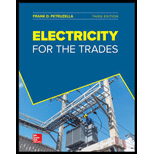
ELECTRICITY FOR TRADES (LOOSELEAF)
3rd Edition
ISBN: 9781260437454
Author: Petruzella
Publisher: MCG
expand_more
expand_more
format_list_bulleted
Concept explainers
Textbook Question
Chapter 1.2, Problem 9RQ
Compare what GFCIs and AFCIs protect against.
Expert Solution & Answer
Want to see the full answer?
Check out a sample textbook solution
Students have asked these similar questions
Find the valve of the voltage Vx using the THEVENIN
equivalent circuit and redo the problem with the
NORTON equivalent circuit. Show both the the vinen
and Norton circuits.
I
12V
m
1
ww
3
23
+
43Vx
5
63
ми
Find the valve of V using the Thevenin Equivalent Circuit
and then determine if the 8 ohm resistor allows
maximum power transfer. If not, then what value
should the 8 ohm resistor be changed to for maximum
power transfer?
ZA
6
6
+
22V
83
V
34
2
6
АААА
АААА
Find the valve of voltage Vx using the THE VIN IN
equivalent circuit
ww
8
Show the Theven in Circuit.
I 7V
ZV
m
6
5
M
+
4 34
АА
3
1
АААА
9A
↑ 24
Chapter 1 Solutions
ELECTRICITY FOR TRADES (LOOSELEAF)
Ch. 1.1 - Does the severity of an electric shock increase or...Ch. 1.1 - In general, voltage levels above what value are...Ch. 1.1 - In general, current levels above what value are...Ch. 1.1 - What circuit fault can result in an arc flash?Ch. 1.1 - Define each of the following terms associated with...Ch. 1.1 - Explain why an arc flash is so potentially...Ch. 1.1 - What is a permit-required confined space?Ch. 1.1 - What does the term personal protective equipment...Ch. 1.1 - What personal protective attire is required when...Ch. 1.1 - When should face shields be worn?
Ch. 1.1 - A fall arrest system must be rigged so that...Ch. 1.1 - A ladder is used to reach the top of a building 16...Ch. 1.1 - What are the deck requirements for a scaffold work...Ch. 1.1 - Prob. 14RQCh. 1.1 - List the three ingredients required to sustain a...Ch. 1.1 - Which classes of fire are multipurpose...Ch. 1.1 - List four hazardous properties or characteristics.Ch. 1.2 - Prob. 1RQCh. 1.2 - Compare the terms grounding and bonding.Ch. 1.2 - Why is the earth not considered to be an effective...Ch. 1.2 - Explain what is meant by a ground fault.Ch. 1.2 - How does a ground-fault circuit interrupter (GFCI)...Ch. 1.2 - How does a ground-fault circuit interrupter (GFCI)...Ch. 1.2 - Explain what is meant by an arcing fault.Ch. 1.2 - Compare the amount of current that results from...Ch. 1.2 - Compare what GFCIs and AFCIs protect against.Ch. 1.2 - What does a lockout-tagout procedure refer to?Ch. 1.2 - Prob. 11RQCh. 1.2 - A voltmeter is used to verify that no voltage is...Ch. 1.2 - What is the main goal of OSHA?Ch. 1.2 - What is the primary purpose of the rules set forth...Ch. 1.2 - Assume a piece of electrical equipment has been...Ch. 1.2 - How often is the National Electrical Code updated...
Knowledge Booster
Learn more about
Need a deep-dive on the concept behind this application? Look no further. Learn more about this topic, electrical-engineering and related others by exploring similar questions and additional content below.Similar questions
- help on this question about power electronics?arrow_forwardA speech signal has frequencies in the range 50- 3500 Hz. The signal is sampled at Nyquist sampling rate and the resulting pulses are transmitted over PAM and PCM systems. 1- Calculate the minimum bandwidth of the PAM system. 2- Calculate the minimum bandwidth of the PCM system, when the pulses are quantized into 121 levels B) Draw the signaling waveform (line codes) for the binary sequence 10110001 using (Unipolar NRZ, Bipolar RZ, Bipolar NRZ, Manchester code, Differential Manchester (split phase).arrow_forwardDon't use ai to answer I will report you answerarrow_forward
- Don't use ai to answer I will report you answerarrow_forward8-1) similar to Lathi & Ding, Prob. P.5.1-2 The figure below shows the Fourier spectra of signals of g,(t) and g₁(t). Determine the Nyquist rate and the corresponding sampling interval for signals of g,(t), g,(t), g₁(1) - g¸(1), g¸³(t), and g₁(1)g₁(1). Hint: Use the frequency convolution and the width property of convolution. G₁(f) G₂(f) -8000 0 8000 f -20000 10 20000 farrow_forward• We will use the Wattmeter to find the average power supplied/absorbed by each component. The following figure shows how to connect the Wattmeter to measure the average power absorbed by the resistor. Note that the Wattmeter consists of a Voltmeter and an Ammeter. The Voltmeter must be connected in parallel with the component and the Ammeter must be connected in series with the component. You must pay attention to the polarity of the voltage across the component as well as the direction of the current flowing through the component. 5Vpk 1kHz 30° ww 40 Z=A-JB Wattmeter-XWM1 2.503 W Power factor: 1.00000 Voltage Current • • Similarly connect a second Wattmeter to measure the average power supplied by the source. Connect a third Wattmeter to measure the average power in the capacitor. Does this value agree with the theoretical value? Perform Interactive Simulation under Analysis and Simulation. Double click on Wattmeters to see the average power values. Note that the Wattmeter also…arrow_forward
arrow_back_ios
SEE MORE QUESTIONS
arrow_forward_ios
Recommended textbooks for you
 EBK ELECTRICAL WIRING RESIDENTIALElectrical EngineeringISBN:9781337516549Author:SimmonsPublisher:CENGAGE LEARNING - CONSIGNMENT
EBK ELECTRICAL WIRING RESIDENTIALElectrical EngineeringISBN:9781337516549Author:SimmonsPublisher:CENGAGE LEARNING - CONSIGNMENT

EBK ELECTRICAL WIRING RESIDENTIAL
Electrical Engineering
ISBN:9781337516549
Author:Simmons
Publisher:CENGAGE LEARNING - CONSIGNMENT
FMPR-103 pt1 l Power Systems Protection v1; Author: L&D for Protection and Control;https://www.youtube.com/watch?v=ELWncjsh5uE;License: Standard Youtube License